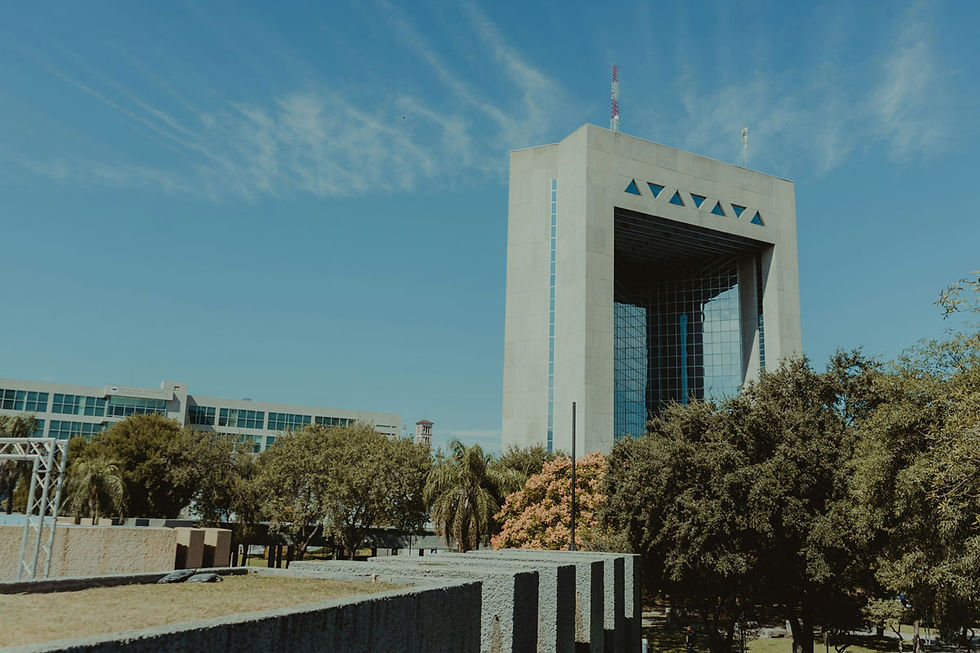Nuevo León 2027: The Political Battle That Could Redefine Northern Mexico's Future
- Editorial

- Jun 18
- 4 min read

With the gubernatorial elections in Nuevo León scheduled for 2027, the political landscape in this strategic northern Mexican state is already taking shape with an intensity that transcends regional borders. In a binational context marked by investment relocation, migration pressure, digital cross-border commerce, and the strengthening of nearshoring, what happens in Nuevo León will have direct implications not only for Mexico City but also for Washington.
According to the latest poll published on June 16, 2025, by Massive Caller, if elections were held today, Morena would lead with 31.8% of voter intention, followed by Movimiento Ciudadano (MC) at 17.1%, PAN at 16.9%, and PRI at 13.2%. While these figures show Morena with an apparent advantage, the fragmentation of the opposition vote and the high percentage of undecided voters (14.1%) keep the race wide open.
From January to June of this year, Morena has shown consistent growth, rising from 27.1% to 31.8%. This increase aligns with the momentum from Claudia Sheinbaum’s presidential victory and the rising popularity of local figures like Andrés Mijes and Tatiana Clouthier, who lead voter preferences depending on whether the candidate is male or female, respectively.
Movimiento Ciudadano continues to rely on the popularity of Luis Donaldo Colosio Riojas (30.8%) and Mariana Rodríguez (29.9%), maintaining its position as the second force, especially in Monterrey, a key urban hub in Mexico’s economy. However, the party’s lack of a clear candidate definition may stall its growth, especially amid internal tensions and national pressure to either go solo or join a broader opposition alliance.
In PAN, the scenario is more complex. Mauricio Fernández Garza leads internally with 32.4%, but voter intention for the party has seen a slight decline. Meanwhile, 63.3% of PAN and PRI supporters support forming an electoral alliance—possibly the only viable strategy to compete effectively against Morena’s political machinery.
Adrián de la Garza emerges as PRI’s strongest internal candidate with 47.9% support. However, the party is still struggling to regain lost ground over the past decade and faces significant challenges in terms of renewing its message and leadership. While PRI retains a historical base in Monterrey’s metro area, it struggles to connect with younger voters and the entrepreneurial sector, especially against fresher faces like Colosio and Clouthier.
At the national level, public perception of political parties in Nuevo León is strongly shaped by their governance performance in other states. Morena currently governs 23 states, granting it unprecedented territorial power. In states like Sonora, Baja California, Campeche, and Veracruz, Morena has showcased its model of centralized administration, robust social programs, and anti-corruption narratives. Still, these administrations have faced serious criticism for insecurity, lack of transparency, and weak urban management. For Nuevo León voters, this has created a dual perception: some admire the social reach and presidential backing, while others fear a loss of state autonomy and setbacks in innovation and civil liberties.
Movimiento Ciudadano governs Jalisco and, as of 2024, Yucatán. Its modern, technocratic, and pro-investment image stems from policies focused on infrastructure, digital services, and public-private partnerships. However, challenges in water policy, media relations, and transparency issues have limited its appeal in more conservative regions. In Nuevo León, MC enjoys favorable media attention thanks to Governor Samuel García, but must ground this popularity in tangible achievements.
PAN remains strong in Guanajuato, Querétaro, and Chihuahua, where it promotes a governance style based on economic development, public safety, and foreign investment. Yet, its rigid structures and generational disconnect make it less attractive to progressive urban voters, particularly in cities like Monterrey.

PRI governs only through alliances in states like Coahuila and Durango. Although it retains political infrastructure and experienced figures, it is weighed down by its legacy of corruption and outdated narratives. In Nuevo León, PRI is attempting a comeback with familiar names but lacks the innovative discourse necessary to capture the electorate’s attention.
Undecided voters—still representing 14.1%—could swing the results. Over the next 18 months, campaign teams must focus on key issues such as security, mobility, affordable housing, foreign investment, and sustainable water management. These are pressing concerns for an increasingly demanding and polarized electorate.
From a binational perspective, the 2027 election is particularly important due to Nuevo León’s economic role on the northern border. With over 2,400 foreign companies operating in the state, a growing electromobility cluster, and close tech cooperation with Texas, the next governor will hold the keys not only to regional development but also to shaping Mexico–U.S. relations—especially in terms of the USMCA, energy transition, and supply chain realignment.
Technology will also play a defining role in the race. AI, digital micro-targeting, social media bots, and mobile citizen engagement platforms are now part of modern electoral playbooks—especially among voters under 35. Candidates who can successfully translate their political message into a digital language will be best positioned for victory.

Ultimately, the biggest challenge for any candidate will not only be to win but to govern effectively. The next administration must strike a balance between investment and social justice, technological openness and cybersecurity, and international cooperation with strong local identity. Nuevo León demands immediate results, effective policies, and visionary leadership.
The 2027 race won’t just mark the beginning of a new term—it may define whether Nuevo León becomes Mexico’s most advanced node of political, economic, and technological integration with the United States.
Escrito por: Editorial




Comments